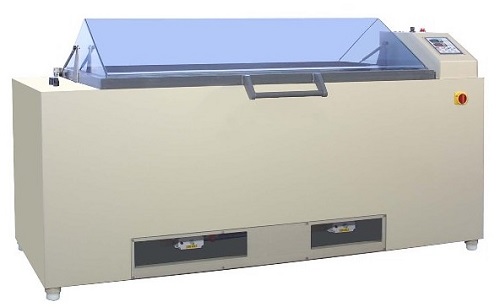Horizontal model
Inquire productCORROSIONBOX chambers are what you need to predict the corrosion resistance and life expectancy of your product.
All over the world the materials used by the manufacturing industry are exposed to natural or industrial corrosion in the form of salt fog, humidity, smoke and vehicle exhaust gases. Corrosion tests in the laboratory are used massively for the selection of materials and the protection of their surface.
Salt Spray Test NSS
A 5% NaCl corrosive solution at a temperature of 35 ° C is transformed into a vapor mist by a nozzle. The misting element diffuses the fog and distributes it over the entire test area. The compressed air, necessary for the formation of the fog, is heated and saturated with humidity inside a pressurized humidifier, before it reaches the nozzle. One or more immersed resistances, depending on the capacity of the chamber, ensure a uniform temperature inside the test chamber. The waste solution is collected at the bottom of the test chamber and flows through a tube. At the end of the test the degree of corrosion of the sample is then evaluated and documented. Intermediate checks can be useful to check the progress of corrosion during the test.
Standard ASTM B117, ISO 9227, JIS Z 2371, ASTM G85
Acetic Salt Spray Test ASS
Cuproacetic Salt Spray Test CASS
Two variations to the standard salt spray test can be obtained by modifying the test saline solution and then the chemical composition of the fog inside the test equipment so as to recreate environments with different aggressiveness. The tests in Salt Spray NSS ASS and CASS can be performed with all the available models.
Condensation Humidity Test
The bottom of the test chamber is filled with demineralized water. The water is heated up to evaporation, condensing on the surface of the samples. The chamber temperature is 40 ° C. The continuous condensation test can be performed with all available models.
STANDARD UNI EN ISO 6270, DIN 50017
Cyclic Corrosion Test
A large number of cyclic corrosion tests can be carried out by combining a saline mist environment with condensate and air drying humidity in accordance with a wide range of international standard tests. Cyclic corrosion tests have recently become increasingly necessary to better simulate natural corrosion in the laboratory. Dry Corrosion and Prohesion are the most common cyclic tests, they are performed by alternating saline fog and air drying.



